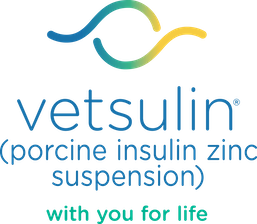

Feeding Schedule
Learn More About Dosing & Administration
Feeding Schedule for Cats with Diabetes
Effective glycemic control is dependent upon a controlled and consistent dietary intake. It’s important to achieve and then maintain a normal body weight, because this is a strong indicator of good diabetes control.
Body weight is a major factor in diet selection. Obese cats require reduced caloric intake, either through feeding a calorie-restricted diet or a reduced quantity of the normal diet. Increasing physical activity will also benefit obese cats. In contrast, underweight cats may require calorie-rich diets such as pediatric or convalescent foods.
Another important consideration is the presence of concurrent disease, for example, renal failure or pancreatitis. In some cases, dietary management for associated problems is more critical than a specific diabetic diet. Also, any concurrent infection, inflammation, or hormonal or neoplastic disorder can interfere with insulin therapy.
Dietary Treatment of Cats with Diabetes6
Control weight
- Average daily caloric intake for a geriatric pet should be 30–50 kcal/kg.
- Adjust daily caloric intake on an individual basis.
- If required, eliminate obesity by decreasing calories and feeding diets designed for weight loss.
Feeding recommendations
- Cats are obligate carnivores and naturally require a high-protein diet.
- Though diet needs to be tailored to a cat’s individual needs, high-protein, low-carbohydrate foods are ideal for many cats with diabetes. (Typically a diet with less than 10% total calories as carbohydrates.)
- If feeding dry food, ideally a prescription diet formulated for cats with diabetes should be fed. There are many non-prescription, canned cat foods that can be utilized in cats with diabetes.
Timing of meals
For twice-daily Vetsulin® (porcine insulin zinc suspension) dosing of cats:
- Inform clients the precise amount of food they should be feeding their cat.
- Keep caloric content of meals consistent.
- Maintain consistent timing of feed schedule, as well as time between feeding and insulin administration.
- Feed one-half of the total daily food intake either concurrently with or right after Vetsulin administration (at 12-hour intervals).
- Cats accustomed to ad libitum feeding may continue to graze throughout the day and night.
Help Your Practice Manage Diabetes Mellitus
Check out these tools and resources to help manage feline diabetes.

Blood Glucose Curve Generator
Create a blood glucose curve to monitor and evaluate diabetes treatments.

Client Discharge Form
Create a customized, printable form for clients about their new diagnosis.

Diabetes Resources
Access online tools and more to support staff and pet parents.
No items to show.
Learn More About Dosing & Administration
Important Safety Information:
Vetsulin® should not be used in dogs known to have a systemic allergy to pork or pork products. Vetsulin is contraindicated during periods of hypoglycemia. Keep out of reach of children. As with all insulin products, careful patient monitoring for hypoglycemia and hyperglycemia is essential to attain and maintain adequate glycemic control and prevent associated complications. Overdosage can result in profound hypoglycemia and death. The safety and effectiveness of Vetsulin in puppies, breeding, pregnant, and lactating dogs has not been evaluated. See package insert for full information regarding contraindications, warnings, and precautions.
References:
1. Martin GJ, Rand JS. Pharmacology of a 40 IU/ml porcine lente insulin preparation in diabetic cats: findings during the first week and after 5 or 9 weeks of therapy. J Feline Med Surg. 2001;3(1):23–30. 2. Vetsulin® (porcine insulin zinc suspension) [Freedom of Information Summary]. Millsboro, DE: Intervet Inc.; 2008. 3. Data on file, Merck Animal Health. 4. Graham PA, Nash AS, McKellar QA. Pharmacokinetics of porcine insulin zinc suspension in diabetic dogs. J Small Anim Pract. 1997;38(10):434–438. 5. Martin GJ, Rand JS. Pharmacokinetic and Pharmacodynamic Study of Caninsulin in Cats with Diabetes Mellitus. 2000: Internal Study Report. 6. Feldman EC, Nelson RW. Canine and Feline Endocrinology and Reproduction. 3rd ed. St. Louis, MO: Saunders; 2004:539–579. 7. Tennant B, ed. BSAVA Small Animal Formulary. 4th ed. Gloucestershire, UK: British Small Animal Veterinary Association; 2002. 8. Feldman EC, Nelson RW. Canine and Feline Endocrinology and Reproduction. 3rd ed. St. Louis, MO: Saunders; 2004:486–538. 9. Reusch C. Feline diabetes mellitus. In: Ettinger SJ, Feldman EC, eds. Textbook of Veterinary Internal Medicine. 7th ed. St. Louis, MO: Saunders; 2010:1796–1816. 10. Nelson RW. Canine diabetes mellitus. In: Ettinger SJ, Feldman EC, eds. Textbook of Veterinary Internal Medicine. 7th ed. St. Louis, MO: Saunders; 2010:1782–1796. 11. Burgaud S, Riant S, Piau N. Comparative laboratory evaluation of dose delivery using a veterinary insulin pen. In: Proceedings of the WSAVA/FECAVA/BSAVA congress; 12–15 April 2012; Birmingham, UK. Abstract 121. 12. Burgaud S, Guillot R, Harnois-Milon G. Clinical evaluation of a veterinary insulin pen in diabetic dogs. In: Proceedings of the WSAVA/ FECAVA/BSAVA congress; 12–15 April 2012; Birmingham, UK. Abstract 122. 13. Burgaud S, Guillot R, Harnois-Milon G. Clinical evaluation of a veterinary insulin pen in diabetic cats. In: Proceedings of the WSAVA/FECAVA/BSAVA congress; 12–15 April 2012; Birmingham, UK. Abstract 45. 14. Davison LJ, Walding B, Herrtage ME, Catchpole B. Anti-insulin antibodies in diabetic dogs before and after treatment with different insulin preparations. J Vet Intern Med. 2008;22:1317-1325. 15. Banfield State of Pet Health 2016 Report. p 12-13.
